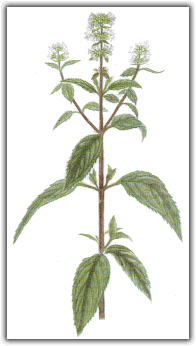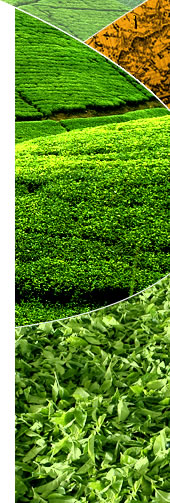| |
 |
![]()
Cooper's Chronicles: Peppermint
THE PEERLESS PEPPERMINT
By Barry P.W. Cooper
When Persephone found out that Pluto was in love with the beautiful nymph Minthe, jealousy burned within her and she changed Minthe into a lowly plant. Pluto couldn't undo Persephone's spell but he did soften it a little so that the more Minthe was tread upon the sweeter her smell would become. The name Minthe changed to mentha and became the genus name for mint. Few people now consider it a lowly plant, particularly those involved in the business of toothpaste and chewing gum and even those selling herb teas.
 However, if someone tries to sell you a packet of peppermint seeds, grab onto your wallet and head for the door. Peppermint doesn't produce seed. It is a sterile hybrid of mentha spicata and metha aquatica (which makes you wonder about Minthe!). Anyway, peppermint must be propagated by cutting, dividing, or layering. In fact, these are the best ways to propagate all mints. It is the only way you can be sure that you will get the plant you want and, in the big business of mint production, getting what you want is critical.
However, if someone tries to sell you a packet of peppermint seeds, grab onto your wallet and head for the door. Peppermint doesn't produce seed. It is a sterile hybrid of mentha spicata and metha aquatica (which makes you wonder about Minthe!). Anyway, peppermint must be propagated by cutting, dividing, or layering. In fact, these are the best ways to propagate all mints. It is the only way you can be sure that you will get the plant you want and, in the big business of mint production, getting what you want is critical.
As an herb tea, peppermint has some wonderful attributes. For a start, it is very traditional and has been used for hundreds of years as a beverage. Secondly, it is freely available in Europe and America so supply was never an issue. Lastly, it has the distinctive advantage of being a single herb that requires no additional flavoring and can be packed as an individual product but can be line priced with herb blends that cost a great deal more. Peppermint is thus the most profitable of all herb teas.
Peppermint, for many years, was grown in Germany but over time the cost of production has forced production further and further into the less expensive Balkan and Adriatic countries. The U.S. has thus become an important source for peppermint for the herb trade. The leaf is processed into coarse cut for export and tea bag cut for domestic sales; although more overseas buyers are now prepared to purchase tea bag cut material directly from source as the producers have mastered the art of refining the leaf to meet very tight density specifications abounding in the herb tea industry.
Most of the mint produced in the U.S. comes from the Pacific Northwest and is a variety of the English mint mentha piperita, although the mint family also includes such flavorful members as sage, rosemary, oregano and thyme. Mints are grouped together because they have several distinguishing characteristics such as square stems, wood leaves in pairs opposite on the stem and bilabiate (two lipped) corollas (the flower petals).
The major growing areas for mint in America are in the Midwest (Indiana, Michigan and Wisconsin) and in the Pacific Northwest (Washington, Oregon, Idaho and Montana). The Pacific Northwest produces the majority of the leaf as well as peppermint and spearmint oil. The primary leaf growing regions are Eastern Washington, Central Oregon and the Willamette Valley. Each of these regions have their own distinct characteristics caused by the local climactic conditions, soil types, etc.
Peppermint is a perennial crop that grows back each year from the stolons (underground stems). In order to achieve the highest volatile oil content, a very important feature of the value of peppermint, the crop is harvested just prior to the plants' flowering.
The mint season begins in the Pacific Northwest in June and continues through August-September depending upon the weather conditions. After cutting, the peppermint is allowed to sun dry and then it is collected by combine harvesters which deposit the cut peppermint directly into trucks for transportation to the extraction plant (in the case of oil) or to the leaf processing plant.
Just like the black tea industry, the processing involves cutting, sifting and sorting in order to remove a percentage of stalk in the raw leaf. Two forms of material are made for the tea industry, a rough cut peppermint leaf similar in size to the orthodox grade broken pekoe souchant and the regular tea bag cut size which is similar in size to a BOP fannings grade.
Many buyers require their tea bag cut leaf to be of a certain density which is why botanical suppliers specifically acquire equipment capable of modifying the density of the leaf to meet this important criteria.
Located in Salem, Oregon, is Core Botanica. This company specializes in leaf products, including mint, and has focused on producing products for the tea industry. The company utilizes plant propagation at its direction to develop various strains of peppermint and to keep the material true to species and free from disease.
Joe Carlson of Core Botanica is particularly enthusiastic about his company's comprehensive quality control and quality assurance programs. "We have three field managers who are responsible for monitoring the quality of the peppermint fields for the states of Washington and Oregon. We constantly check the leaf oil composition and content as the plant is growing to ensure that we maximize leaf quality at harvest time."
"Oil composition and content defines taste and we have our own fully equipped laboratory that performs all the testing. During the season the lab works 16 hours a day compiling data on all the fields under contract to Core Botanica. We also closely monitor the temperature and weather conditions in the three primary growing areas to enable us to harvest at the optimal moment."
"Nothing about our operation is haphazard," explained Carlson. "From the cuttings in the nursery through to our field operations and the processing of the leaf and finally in packing for export Ð all are carefully planned. This is a business that does not allow for many mistakes in judgment. You have to know which fields to harvest and why, and if you make a mistake the weather may close in the following day and severely impact the field's leaf."
"Knowing the taste characteristics of the growing areas is also an important function but, as with all agricultural products, we are dependent upon the weather for quality of our final product. How it tastes still depends upon the weather."
When Persephone first got nasty she probably had no idea that in time it would be the nymph Minthe who would be remembered by millions of people as the Peerless Peppermint, enjoyed daily around the world and none more so than by consumers of herb tea.

|
|